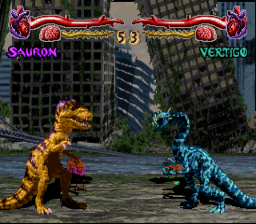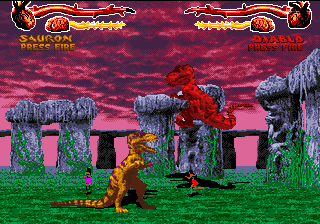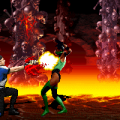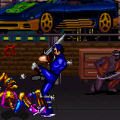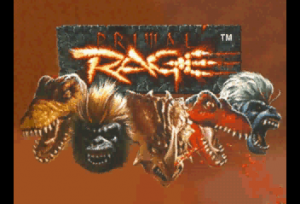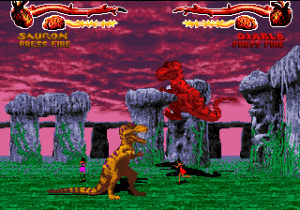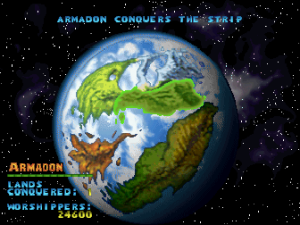- Primal Rage
- Primal Rage II
Everyone knows Street Fighter II and the flood of clones and rip-offs that came in after, some of which eventually developed into something respectable. Since Mortal Kombat was another really big thing at the time, it had a quite a number of its own competitors trying to steal its thunder. Some of these were pretty good for the time, like Killer Instinct, and some were just pure crap, like Time Killers. Others had interesting ideas and potential for something greater hidden under bad design decisions and poor control, and Primal Rage falls closer to the latter.
The game was originally created for the arcades by Atari Games, the same people who brought out stuff like Gauntlet, Marble Madness, and Area 51, the light-gun game that you’ll still find every American arcade/movie theater, even over a decade later. The idea’s not entirely original, since Taito made a game about battling dinos a couple of years before called Dino Rex, which was pretty much worthless in every way. Primal Rage‘s success also can be credited to the dinosaur fever introduced to American youuths thanks to the release of the Jurassic Park film the year before.
The basic plot of Primal Rage is that, in the far future, a meteor hits the earth and destroys civilization, turning humanity into nothing more than a bunch of scattered tribes. Not only that, but six ancient gods (not counting the guy who turned himself into a farting gorilla) trapped within the planet get released from eons of imprisonment, each taking the form of a prehistoric beast and taking a piece of the new ‘Urth’. (Intentionally spelling things wrong was a big fad back in the ’90s, you see. Be thankfully they didn’t stick an inappropriate “z” in there anyway.) They’ve all got their own agendas, but it all boils down to them murdering each other so they can conquer the whole world.
Characters
Armadon
Armadon is covered in sharp spines he uses in combat along with his horn. As the god of life, he battles the other gods because their fights are slowly destroying what’s left of the planet. Gameplay wise, he’s a little similar to Blanka, with a rolling attack and a move where he crouches and extends his spines to protect himself from attacks.
Blizzard
Blizzard is one of the game’s two gorilla pallete-swaps. As the god of virtue and the closest thing this game has to a true hero, he fights to protect mankind and restore the planet to what it once was. Although he’s still allowed by the game to eat just as many humans as any of the bad gods. He’s been described as a de-evolved cross between Balrog and Sub-Zero, which isn’t an unfair thing to say with all his punch moves and ice attacks.
Chaos
Chaos is the other gorilla in the game, and although he’s a lot smaller than Blizzard, he’s got more speed on him. Although he’s actually a human scientist who transformed himself into a gorilla somehow, he’s supposed to be the god of decay, who fights to return to his original form. He fights with puking, farting, and other pleasant bodily functions. He also has some of the lamest fatalities in the game.
Sauron
Sauron (no, not that Sauron) is one of the game’s two T-Rexes, and the god of hunger. It’s pretty sad that four out of the seven characters are just similar variations on each other, but that’s just how things worked in early ’90s fighting games. Oddly enough, even though his ending has him eating every human in the entire world, the game’s backstory considers him a “Virtuous Beast”. He’s one of the game’s slower characters, although he can get in a lot of damage pretty quickly.
Diablo
Diablo is the other T-Rex, although he’s a good bit smaller than Sauron. He’s the god of evil, and his entire character basically boils down to being Satan in T-Rex form – which, you have to admit is pretty badass, if incredibly cheesy. Unlike Sauron and the rest of the characters, he’s more meant to used at a distance from the opponent.
Talon
Talon the velociraptor is the the god of survival, and even though the game also says he’s supposed to be a good guy, considers the humans as cattle. He’s not only the fastest character in the game, but also the smallest, which can make him a bit of a pain to fight at times.
Vertigo
Vertigo isn’t based on any real kind of dinosaur, but the best way to really describe her would be that she’s part snake and part dino. She’s the only female in the game and the goddess of insanity, who wants to torture and enslave the humans of Urth. She’s not one of the game’s better characters, and although she has a lot of moves which stun the opponent, she lacks a lot of power the other gods have.
The game uses stop-motion animation for all of its playable characters instead of sprites or CGI, which makes the entire game look a little like a Ray Harryhausen film. It’s a fitting look for a cheesy game like this, and the sprites are pretty big for the time period, although the animation is somewhat on the choppy side There’s a lot of little touches and bits of detail in the game, some of which are more obvious than others. It’s got what’s quite possibly the coolest health bar in any game ever made. Health is represented by an artery sticking out of a heart, which beats faster and faster as damage is taken until it explodes, making a big bloody mess of the loser’s corner of the screen. The game also shows how close you are to a dizzy with a yellow brain meter, which crackles with electricity when somebody gets stunned and disintegrates into ash when they lose.
There’s also the little human worshippers that follow after the gods as they move across the screen and react as the battle continues. They cheer when their god inflicts damage, and weep and fly into the air when their god stomps the ground before pulling themselves up, among other things. One of the cooler features of the game is that worshippers will actually run into the foreground and start bowing at their god’s feet when he achieves a combo or gets dizzy, and it’s at this point when either player can actually nab them off of the ground with a special move and eat them alive, earning them a little bit of extra health back. The worshippers are actually digitized sprites of the development team, although you can’t really get any kind of close look at them.
The sound is fairly unremarkable, as far as these kinds of games go. Seeing as most of the characters don’t have properly developed vocal cords, there’s lots of roaring, grunting, and hissing, as you’d expect. Most of the music is tribal-sounding stuff with lots of flutes and drums, except for Sauron’s theme, which, inexplicably enough, has a riff from “Smoke on the Water” in it.
Of course, as you’d expect, there’s plenty of blood, possibly even more in regular gameplay than Mortal Kombat. Every character gets three fatalities, although none of them really have the spectacle that the ones in MK ever had. They range from the OK, like shredding up your opponent into a mangled mess, to the stupid, such as uppercutting your enemy into the background, complete with slide whistle sound effect. And some of them just get plain weird, like the one where Chaos can jump into the background of certain stages, splashing into the water and leaving his opponent stunned and unkilled.
Unlike Mortal Kombat and similar games which had a pretty odd control layout just so they could be different from Street Fighter, Primal Rage is a bit more like a Capcom or SNK effort. There are four buttons for weak and strong attacks that hit high and low, and hitting two high or low buttons together gives a heavy attack. Blocking is accomplished by holding back on the joystick, just like nearly every other fighter (except Mortal Kombat, of course.) Something to note is that this is actually one of the first fighting games where there’s multiple ways to jump. Along with the normal jump, there’s a short hop you can do, like the Samurai Shodown games, along with a high jump that would be seen in later games like Capcom’s VS series.
The basic moves aren’t difficult to pull off, but trying pull off special moves is game’s biggest flaw. It all depends on what version you’re actually playing, but if you’re unlucky, you’ll need to hold down one or more buttons and then put in the directional motion to perform all the special moves in the games. To Atari’s credit, the later arcade revisions and some of the ports made it so moves can be done the usual way, by doing the inputs and then hitting the buttons. The problem is that you still have to hit at least two buttons for ALL of the moves, and depending on which buttons they are and the controller you’re using to play the game, you might have to move your fingers in some uncomfortable ways.
Memorizing moves is a lot more difficult than in Capcom and SNK’s stuff, too, because unlike those games, where you only had to hit one button for each move, you have to remember how many and which of the four buttons the game wants you to hold, as well as the directional motion, which constantly switches from MK-style to quarter-circles. A move list is definitely recommended to keep by your side.
There’s a lot of focus on pulling off combos, and this game is from the era where fighting game developers just started putting importance on them. There’s no dial-a-combos like in MK3, so there’s a good bit of freedom involved in how you want to do it if you can figure out the special moves. Some combos actually have a name that appears on screen after they’re performed, with silly names like “SUPER STEAMROLLER COMBO” and “THANK YOU FOR FLYING SAURON AIRLINES!” The game also makes some effort to stop infinites and cheap moves, and if you try something that the game considers “cheesy”, it’ll actually flash a “no cheese” symbol and end your combo, letting the opponent counterattack.
Oddly enough, the game completely lacks anything close to a final boss. After beating all seven gods (including a mirror match) and conquering the Urth, you’re put in a bonus round where you need to eat as many followers as possible to prepare you for the “Final Battle”. As it turns out, the “Final Battle” just one long endurance round where you need to beat all of the six other gods on one health bar. The final arena is pretty cool, a barren dinosaur graveyard where the gods you defeat turn into skeletons that litter the background, but the climax is pretty lacking. Street Fighter had Akuma, Mortal Kombat had Shao Kahn, and Primal Rage just has what’s basically a boss rush. After you beat all the characters again, you get a screen of text explaining what your character went on to do along with a pretty nice picture.
Primal Rage had a huge amount of hype behind it at the time for a couple of years, with ports for every single platform on the market at the time. Somehow, the thing managed to make it onto the Jaguar CD, of all consoles.
The Genesis version is one of the worst non-portable ports (although, not THE worst) the game got. Not only are the sprites tiny, with an uncountable number of missing frames, but the lack of color pallete makes the backgrounds a blurry mess. It also suffers from the big drop in sound quality most Genesis ports were known for. That wouldn’t be much of a problem if the gameplay stayed intact, but even that didn’t get ported properly. The code is based off of one of the earlier, less polished arcade versions, and pretty much any combo that could be done in the arcade version just can’t be done at all here. This version does feature a code to summon the Fergus Devil, a small being with the head of Fergus McGovern, the same guy in the “Fergality” special moves in the Genesis version of Mortal Kombat 2. The 32X version has much more accurate graphics and colors, but still suffers from all the same gameplay issues.
The Super Nintendo version has more detailed graphics, although it’s darker and runs at a lower resolution, and while the combo system still isn’t perfect, it’s still a step up over the Sega ports. Oddly enough, this is the only port that was subject to any kind of censorship. While all the blood, fatalities, and exploding hearts are intact, one of Chaos’s fatalities was removed entirely. If you attempt his ‘Golden Shower’ finisher, the game will give you a ‘no’ symbol while Chaos skips to the victory pose at the end of the fatality.
The Game Boy and Game Gear versions are identical, barring the lack of color on the Game Boy Version. Neither of the portables at the time had any good fighters, and this isn’t any exception. Among the obvious graphical cuts, the gameplay’s been cut down a good bit, and the fighting that remains tends to be choppy and sluggish. Vertigo’s also missing entirely. Despite all this, it actually manages to be a better port than Street Fighter II was on the Game Boy.
All of the CD versions are more or less identical, only differing in sprite size. They’re nearly arcade-perfect, except for the loading times that happen between rounds and before fatalities, with the Saturn one coming out at a slight edge due to the higher resolution. There’s even a couple of extra modes added that none of the cartridge versions had. Tug-Of-War is where two gods share one big health bar, like the Death Match mode in World Heroes, and Endurance is a team battle mode where two players pick four characters and fight it out. All the CD versions except for the Jaguar also have an opening FMV that explains the story of the game, showing the meteor destroying the planet while a bored-sounding woman narrates the plot. It then shows Talon and Sauron, animated with terrible CGI, staring each other down. They lunge… and fade to title. The Saturn version has character intro FMVs before you fight each god, but these are even more worthless.
The computer versions are on completely opposite ends of the quality spectrum. The PC version is one of the closest ports to the original arcade, even including a special control setup for keyboards, but it runs at a very low resolution for some reason. The Amiga port suffers from graphics and gameplay on par with the Genesis, along with having the hindrance of only one button to work with. It makes sense – both the Amiga and Genesis versions were ported by Probe Software, who had also done the Genesis port of Mortal Kombat.
An arcade compilation called Midway Arcade Treasures 2 was released in 2004 for the Game Cube, PlayStation 2, and Xbox. Primal Rage is one of the games on there, and it’s supposedly an emulation of the original arcade. Oddly enough, there’s actually a few things that weren’t in the original arcade version at all. All the special moves were changed so they only use one button, which really helps the accessibility. The bad news is that there’s a lot of oddities and bugs that didn’t happen in the original arcade, like the game freezing if Vertigo uses one of her fatalities on Armadon.
While normally the best option would be to skip all the ports and grab the ROMs for MAME, there’s actually some copy protection code nobody’s been able to crack at this time. The protection, among other things, causes all blood not spilt by a heavy attack to be a grayish-brown color, makes some of the combos impossible, and causes some special moves to just not work at all. While members of the original team have been contacted, none of them are willing to help crack the encryption. Sadly, this makes it pretty much impossible to play an 100% arcade-perfect version of Primal Rage right now unless you happen to own the actual cabinet.
Primal Rage isn’t really easy to call a GOOD game, although there’s so, so much worse to compare when you look through pretty much any other Western-made fighting game. It’s definitely inspired by Mortal Kombat, there’s no doubt about that, but it also tries to do its own thing and be a little different. It doesn’t succeed at everything, but if you can look past the massive amounts of cheese and control issues, it can still be a pretty entertaining fighting game. And even then, you still have the draw of having what’s basically Satan in T-Rex form fighting a farting gorilla.
